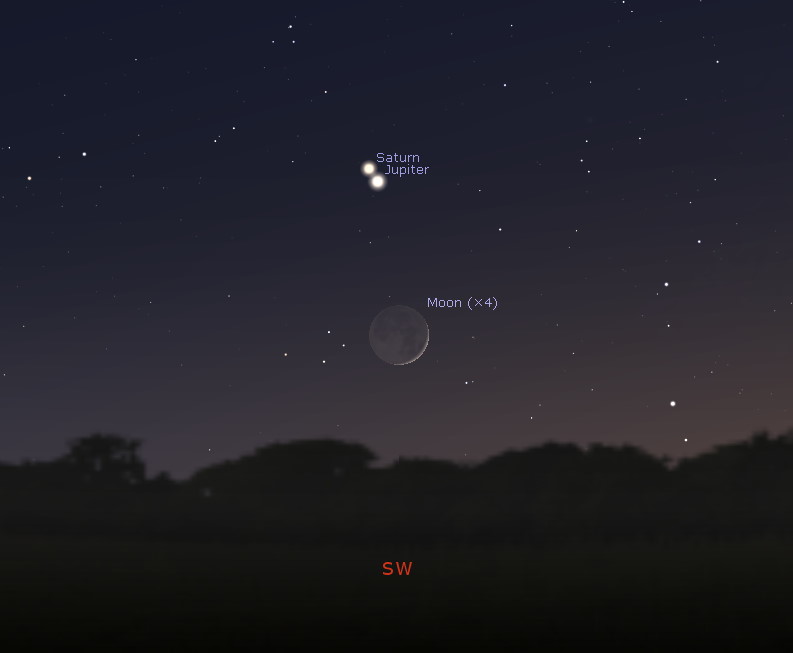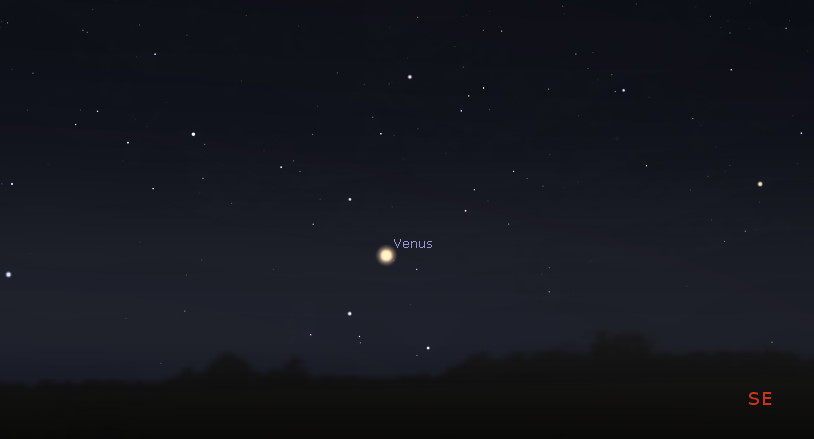
Jupiter and Saturn appear in the southwestern sky at dusk, getting closer getting closer to the Dec. 21 conjunction with each passing day! The waxing crescent Moon joins the pair of planets on Dec. 16 & 17.

Venus appears in the southeastern predawn sky all week, getting closer to the horizon with each passing day.

Mars, Uranus, the Pleiades star cluster and the bright star Aldebaran appear in the east-southeastern sky after sunset this week.

The constellation Lyra, with the bright star Vega appear above the western horizon after sunset this week.


The Moon is a waxing crescent– visible toward the southwest in early evening.
The first quarter Moon occurs on Dec, 21st – visible high in the southern sky in early evening.

If you click on the Moon image above, or click this link, you will go to NASA’s Moon Phase and Libration, 2020 page – it will show you what the Moon looks like right now. If you click the image on that page, you will download a high-rez TIF image annotated with the names of prominent features – helpful for logging your observations!
Moon News
There was a total solar eclipse on Dec. 14th – the Moon’s shadow crossed over the South America.

The Sun has 2 sunspots. Sunspot AR2792 is energetic and poses a threat for C-class solar flares; on Dec. 14th it blew off a C4-class flare, with a coronal mass ejection (CME).

The limb of the Sun where these sunspots are rotating into view show a lot of coronal activity. Both the northern ans southern coronal holes appear to be a bit… lop-sided.
The Sun seen in 193 angstroms (extreme ultraviolet) December 14, 2020:
Lots of prominence activity over the last couple days – time for me to get that new mount for my solar telescope!
The Sun seen in 304 angstroms (extreme ultraviolet) December 14, 2020:
You can view the Sun in near real-time, in multiple frequencies here: SDO-The Sun Now.
You can create your own time-lapse movies of the Sun here: AIA/HMI Browse Data.
You can browse all the SDO images of the Sun from 2010 to the present here: Browse SDO archive.
Solar Activity on Facebook – Run by Volunteer NASA/JPL Solar System Ambassador Pamela Shivak

Solar Corona
Solar wind speed is 310.4 km/sec, with a density of 6.8 protons/cm3 at 1130 UT.
Near real-time animation of the corona and solar wind from the Solar & Heliospheric Observatory (SOHO):

Sun News

Potentially hazardous asteroids: 2037 (last updated June 2, 2020)
Total Minor Planets discovered (NASA): 1,038,961
Total Minor Planets discovered (MPC): 1,026,572
Upcoming Earth-asteroid encounters:
A couple close-passes less than 1 lunar-distance in the next couple days.
| Asteroid |
Date(UT)
|
Miss Distance
|
Velocity (km/s)
|
Diameter (m)
|
| 2018 XU3 |
2020-Dec-15
|
16.7 LD
|
10
|
30
|
| 2020 XF5 |
2020-Dec-15
|
8 LD
|
18.7
|
29
|
| 2020 XF4 |
2020-Dec-16
|
0.9 LD
|
6.8
|
11
|
| 2020 VY1 |
2020-Dec-16
|
13.2 LD
|
4.4
|
24
|
| 2020 XX3 |
2020-Dec-18
|
0.1 LD
|
5.9
|
7
|
| 2020 XF3 |
2020-Dec-18
|
18.2 LD
|
7.6
|
31
|
| 1997 XE10 |
2020-Dec-20
|
13.3 LD
|
7.2
|
36
|
| 2020 XY4 |
2020-Dec-20
|
2.1 LD
|
9.6
|
17
|
| 2017 XQ60 |
2020-Dec-21
|
10.8 LD
|
15.6
|
47
|
| 2020 XA3 |
2020-Dec-21
|
12.7 LD
|
15
|
49
|
| 2020 XJ3 |
2020-Dec-23
|
5.1 LD
|
6.2
|
28
|
| 2011 CL50 |
2020-Dec-24
|
3.1 LD
|
3.4
|
11
|
| 2020 XY |
2020-Dec-25
|
15.7 LD
|
5.7
|
26
|
| 501647 |
2020-Dec-25
|
7.9 LD
|
10
|
123
|
| 2018 XE4 |
2020-Dec-26
|
5.6 LD
|
9.4
|
19
|
| 2020 XT2 |
2020-Dec-26
|
13.1 LD
|
5.2
|
39
|
| 2012 XE133 |
2020-Dec-26
|
12.1 LD
|
9.1
|
74
|
| 2016 AF2 |
2020-Dec-27
|
7.3 LD
|
5.3
|
9
|
| 2020 XZ4 |
2020-Dec-29
|
5.4 LD
|
8.7
|
42
|
| 2012 UK171 |
2020-Dec-30
|
15.5 LD
|
4.7
|
47
|
Notes: LD means “Lunar Distance.” 1 LD = 384,401 km, the distance between Earth and the Moon. Red highlighted entries are asteroids that either pass very close, or very large with high relative velocities to the Earth. Table from SpaceWeather.com
 On December 14, 2020, the NASA All Sky Fireball Network reported 259 fireballs!
On December 14, 2020, the NASA All Sky Fireball Network reported 259 fireballs!
(206 Geminids, 51 sporadics, 1 Monocerotid, 1 Leonid Minorid)

Fireball News
If you see a bright meteor or a fireball, please REPORT IT to the American Meteor Society!
 Position of the planets and several spacecraft in the inner solar system:
Position of the planets and several spacecraft in the inner solar system:

Position of the planets in the middle solar system:

Position of the planets, some dwarf planets and some transneptunian objects in the outer solar system:

Solar System News
Didn’t we know this several years ago?

Mars Persevere Rover:
International Space Station:
Mars InSight Lander
HiRISE – on the Mars Reconnaissance Orbiter:
Hubble Space Telescope #Hubble30
Landsat:
Climate:
Citizen Science:
See a list of current NASA missions here: https://www.jpl.nasa.gov/missions/?type=current

ex·o·plan·et /ˈeksōˌplanət/, noun: a planet orbiting a star other than the Sun.
Data from the NASA Exoplanet Archive
* Confirmed Planets Discovered by TESS refers to the number planets that have been published in the refereed astronomical literature.
* TESS Project Candidates refers to the total number of transit-like events that appear to be astrophysical in origin, including false positives as identified by the TESS Project.
* TESS Project Candidates Yet To Be Confirmed refers to the number of TESS Project Candidates that have not yet been dispositioned as a Confirmed Planet or False Positive.
Exoplanet News
 More Dark Sky Parks!
More Dark Sky Parks!
Hubble: Beautiful Universe

Tour of the Local Stellar Neighborhood
Continuing with my visual tour of nearby stars and their systems, we travel to Groombridge 1618, about 15.88 light years distant.

Groombridge 1618
Groombridge 1618 is a star in the northern constellation Ursa Major. With an apparent visual magnitude of +6.6, it lies at or below the threshold of stars visible to the naked eye for an average observer. It is relatively close to Earth, at 15.88 light years. This is a main sequence star of spectral type K7.5 Ve, having just 67% of the Sun’s mass. There is a suspected planetary companion with an orbital period of 122 days.
Properties
This star was first identified as entry 1618 in the work A Catalog of Circumpolar Stars by Stephen Groombridge published posthumously in 1838. It has such a proper motion across the sky that it guaranteed the star was quite nearby and made it an early candidate for parallax measurements. In 1884 the parallax angle was measured as 0″.322 ± 0″.023, which is larger than the modern value of 0″.205.
Groombridge 1618 has a stellar classification of K8 V, which means it is a K-type main sequence star that is generating energy by fusing hydrogen at its core. It has 67% of the mass of the Sun, 61% of the Sun’s radius, but radiates only 15% of the Sun’s energy and only 4.6% of the Sun’s energy in the visible light spectrum. The effective surface temperature of the star’s photosphere is about 4,000 K, giving it an orange hue.
It is a BY Draconis variable with a surface magnetic field strength of 750 G. The chromosphere is relatively inactive and produces star spots comparable to Sun spots. However, like UV Ceti, it has been observed to undergo increases in luminosity as a flare star.
Planetary System
A search for excess infrared emission from this star by the Infrared Space Observatory came up negative, implying that Groombridge 1618 does not possess a nearby debris disk (such as Vega does). However, observations using the Herschel Space Observatory showed a small excess suggesting a low-temperature debris disk. The data can be modeled by a ring of coarse, highly-reflective dust at a temperature below 22 K orbiting at least 51 AU from the host star. If this star does have a companion, astrometric measurements appear to place an upper bound of 3–12 times the mass of Jupiter on such a hypothetical object (for orbital periods in the range of 5–50 years).
Those observations collated by Marcy & Benitz (1989), tend towards a single notable object with periodicity of 122 days as a planetary object with minimum mass 4 times that of Jupiter. This candidate planet has not been confirmed and the signal the authors had found could have been due to intrinsic stellar activity from the star’s young age. If confirmed, the planet would be within the star’s habitable zone. – Wikipedia
Groombridge 1618 System Diagram

Artist Renderings of (Unconfirmed) Exoplanet Groombridge 1618 b


What I was listening to when I was editing this:
Apologies for the tardiness of this post
One of the parrots we’ve owned for nearly 2 decades passed and it hit me incredibly hard.
https://twitter.com/AstroBalrog/status/1335507984005402624
Stay safe, be well, and look up!
Apps used for this post:
NASA Eyes on the Solar System: an immersive 3D solar system and space mission simulator – free for the PC /MAC. I maintain the unofficial NASA Eyes Facebook page.
Universe Sandbox: a space simulator that merges real-time gravity, climate, collision, and material interactions to reveal the beauty of our universe and the fragility of our planet. Includes VR support.
SpaceEngine: a free 3D Universe Simulator for Windows. Steam version with VR support available.
Stellarium: a free open source planetarium app for PC/MAC/Linux. It’s a great tool for planning observing sessions. A web-based version of Stellarium is also available.
Section header image credits:
The Sky – Stellarium / Bob Trembley
Observing Target – Turn Left at Orion / M. Skirvin
The Moon – NASA/JPL-Caltech
The Sun – NASA/JPL-Caltech
Asteroids – NASA/JPL-Caltech
Fireballs – Credited to YouTube
Comets – Comet P/Halley, March 8, 1986, W. Liller
The Solar System – NASA Eyes on the Solar System / Bob Trembley
Spacecraft News – NASA Eyes on the Solar System / Bob Trembley
Exoplanets – Space Engine / Bob Trembley
Light Pollution – NASA’s Black Marble
The Universe – Universe Today

